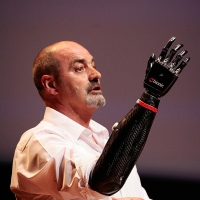Bionic Arm Changes Lives and Offers Glimpse of the Future

Developments in robotics technology may have saved Nigel Ackland’s life.
About six years ago, the Englishman, a former metals smelter, had his right forearm crushed in an industrial accident. After months of surgeries, he elected to get his arm amputated below the elbow. He was no longer able to work, and he fell into a deep depression.
But last year, Ackland was approached by rehabilitative products manufacturer RSLSteeper about participating in a trial of Bebionic3, a robotic prosthetic hand. The company launched the prototype in September after years of developing hardware and software and testing with amputees. The high-tech appendage—the most advanced prosthetic on the market right now—looks like a limb for the Terminator, but Ackland said it actually makes him feel more human because he can perform functions he thought he’d never be able to do again.
The hand contains sensors that detect electrical signals from the skin by voluntary muscle movements of the upper arm. It has fourteen different grips, with up to eight functioning at a time in custom software configurations, allowing Ackland to perform everyday dexterous actions such as typing, tying his shoes, peeling vegetables, and even dealing cards. The hand also has some superhuman abilities—the fingers can lift 100 pounds, and the wrist can rotate a full 360 degrees.
While these functions are invaluable for Ackland, they’re just the tip of the iceberg for what’s being dreamed up by scientists who predict the eventual merging of humans and supercomputers. Rather than reacting to muscle movements, the technology already exists for prosthetics that respond to the user’s thoughts alone. So-called nerve interface technology is also working to connect an artificial limb with a person’s nerves to impart a sense of touch, letting the wearer feel what the prosthetic is touching.
Similarly, brain-computer interfaces that allow people to control a cursor, keyboard, or wheelchair using only their thoughts are already available. From there, the mind wanders to other technological implants for humans that could be on the horizon—computer chips imparting the brain with Google-like search abilities, nanobots in the bloodstream fighting off diseases, or designer bodies giving anyone the strength and speed of the Bionic Woman.
Though these ideas are still in their developmental infancy at best—not to mention quite expensive (Ackland’s robotic hand retails for $25,000 to $35,000)—the potential has some people nervous about scientists “playing God.” It’s hard not to talk about using technology to modify the human body without making the mental leap to some rogue turning himself into Iron Man. But just think of the possibilities for stroke victims, those with spinal cord injuries, or amputees such as Ackland.
Ackland says the best result from his restored physical abilities was the effect it had on him mentally. The psychological benefits of being more self-sufficient and having a hand that actually looks human helped him emerge from his depression and rejoin the world.
See him demonstrate his arm in this video.

